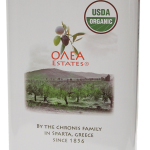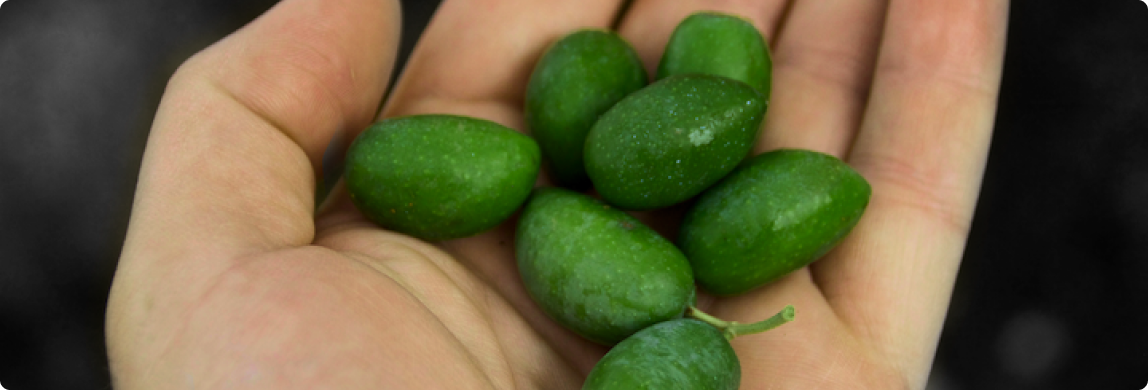
Olea Gold 500 ml - single

Olea 3 lt - single
Subtotal: $215.92

Olea Europea (scientific name for olive) was domesticated in the Eastern Mediterranean around 4000 BC and soon thereafter reached the Greek shores.
To open a bottle of Greek Olive Oil is to pour the Iliad and the Odyssey – 5,000 years of Hellenic culture – on ones salad. And to taste it! There is true genius in a bottle of Greek Olive Oil.
But what is Olive Oil exactly?
For you, the consumer, it is a rather confused product: so many names, so many brands, so many claims…
One thing though is beyond doubt: olive oil which carries the label “virgin” or “extra virgin” is the only oil that is edible from the moment of pressing and that can truly be called a natural product.
In fact, extra virgin olive oil can be compared to wine. Often the best stands next to worst, and prices vary from simple to double and even more. Yet, we all recognize a good wine from a bad one, and we are willing to pay for the difference.
Like a good wine, a good extra virgin olive oil depends on tree variety, soil composition, weather conditions, harvesting and crushing methods. Greece has of course a tradition of thousands of years in all aspects of olive cultivation but what sets it truly apart from the rest of the world is its unique combination of exceptional varieties of trees, soil structures and micro climates.
The truly outstanding quality of Greek extra virgin olive oil has long been recognized by other olive oil producing countries, as witnessed by the large quantities of Greek olive oil they import. These quantities are blended into the local production in order to improve its quality.
Of course, the quality of the genuine Greek extra virgin olive oil will always by far exceed that of any blend or mixture. The information on a label that an extra virgin olive oil is “produced in Greece” or is a “Greek Product” already ensures that the olive oil is of superior quality.
The key to the quality of Olea’s final product lies in the sourcing of its extra virgin olive oil. We supervise and often administer the cultivation, pruning, maintenance, handpicking, pressing and bottling processes as we have been for years. The Olea Estates are only a couple of miles away from the press, where the olive oil is bottled immediately after the first cold press. We ensure the most fresh olive oil you can possibly get. Everything that happens to this olive oil from the root of the olive tree until it reaches your plate is kept within the family. Extra virgin olive oil’s birth is a demanding and passionate affair.
For us at Olea, producing olive oil is more than our specialty, it is our Passion.
The quality debate
A great deal has been written about the quality issues surrounding Olive Oil.
The problem of olive oil begins at the source. Olives are collected from November to February, mostly by hand, in pouring rains and piercing winds. Many olives fall to the ground. These must be collected later. They are bruised and oxidize. This oxidative degradation process raises the acidity level of the olive oil inside the olive. At the mill, fresh olives are pressed first, yielding the juice of the fruit, the olive oil. This is the low acidity extra virgin olive oil that consumers world wide seek out. The bruised ground olives are pressed separately, yielding a high acidity olive oil by the name of “lampante” (from the Italian word for lamp). Lampante olive oil lightened Mediterranean households for millennia (think of Aladdin’s wonder lamp!). At Olea, we discard ground olives altogether and sell them to a different wholesaler market.
Extra-Virgin Olive Oil: intensely flavored oil pressed from the olive fruit by purely physical means; its acidity is very low, ranging from 0.1% to 1%. (Note: the acidity is a measure for how oxidized (bruised) the olives were at the moment of pressing. In addition extra virgin olive oil may also be characterized as “ First Pressed” or “Cold Pressed” (see below).
Virgin Olive Oil: physically pressed olive oil with an intermediate acidity, ranging from 1% to 2%; above 1 pct acidity, Virgin Olive Oil starts presenting organoleptical defects.
First Press: virgin or extra virgin olive oils which are obtained by first mechanical pressing at temperatures lower than 27C (80F), at mills that are equipped with traditional presses.
Cold Press: virgin or extra virgin olive oils which are obtained by filtration or by centrifugation at temperatures lower than 27C (80F).
Unfiltered: Filtration is the final step in olive oil production. In general filtering olive oil removes all of the tiny olive particles that make an oil cloudy. It is often undertaken to ensure that a product will have a uniform clarity across all bottling lots.
Thus, unfiltered oils are often much cloudier than their filtered counterparts. Unfiltered oil often retains more of its olive flavor and often has a different texture and flavor profile that filtered oil.
Lampante or Industrial Olive Oil: physically pressed olive oil unfit for direct human consumption, either because of its organoleptic defects and/or because of its high acidity. Lampante olive oil is collected separately and sent to vegetable oils refineries where its taste and high acidity is removed. The resulting oil is called refined olive oil. It has the same lipids profile as (Extra)-Virgin Olive Oil and is clear, brilliant, lightly coloured, tasteless and odourless. Unfortunately, during the refining process, many valuable micro components, like sterols, tocopherols and trace metals, which are at the root of olive oil health claims, are also removed.
Olive Oil: a confusing term since, in accordance with EU regulations, it refers to a blend between (Extra)-Virgin Olive Oil and… refined olive oil. The advantage of diluting an Extra-Virgin Olive Oil with refined olive oil is that it reduces the sometimes overpowering taste (all these anti-oxidants!) of
Extra-Virgin Olive Oil. If an Olive Oil is made from a blend of top quality refined olive oil and the best Extra-Virgin Olive Oil money can buy, the result is a “light” or “mild” version of that same Extra-Virgin Olive Oil. Olive Oil is also referred to as “Riviera”, “Coupé” or “Pure”.
Olive Pomace Oil: when olives are pressed, the olive oil, which is the juice of the fruit, represents the liquid phase (abt 15%-22% of the olive); the pressed pulp, containing the fruit’s stone –the kernel- represents the solid phase. The kernel still contains some olive oil, which can be extracted and sent to a vegetable oils refinery. The oil resulting form this refining process is called refined Olive Pomace Oil. Refined Olive Pomace Oil is similar in flavor and aspect to refined Olive Oil. As in “Pure” Olive Oil, Extra-Virgin Olive Oil is blended back into the refined Olive Pomace Oil to give it taste, aroma and color. Therefore, the quality of Olive Pomace Oil strongly depends on the quality of the extra-virgin olive oil used for the blend. Olive
Pomace Oil is often referred to as olive “kernel” oil, “sansa”, “orujo”.
Salad Oil: popular in some overseas export markets; a blend of a refined vegetable seed oil (mostly sunflower seed oil) with Extra Virgin Olive Oil. Salad oil does not have the same properties as Olive Oil because the fatty acids profile of seed oils differ substantially from those of olive oil. A Salad Oil is only as good as the worst of its blending components.
At Olea we do not produce anything but only our extra-virgin olive oil obtained by first press of our ripe and selected olives at temperatures under 27oC. We do not blend refined oils and we use no other method of altering our olive quality, taste or color. We do not filter our olive oil, but we do guarantee uniform clarity and no cloudiness. See how we do it. Olea Olive Oil has the true, rich flavor of olive oil and all associated nutrients and is obtained by a strictly controlled and long lasting process, especially for the food connoisseur.